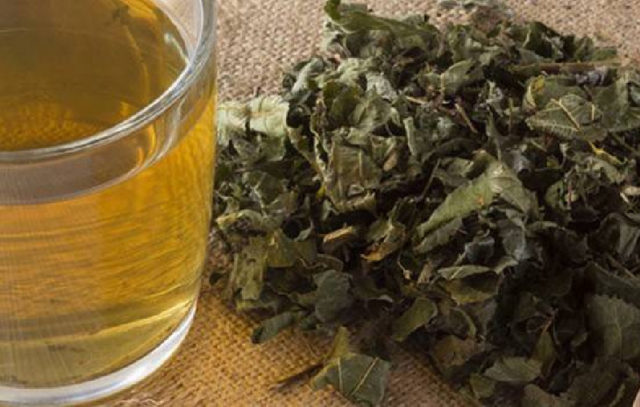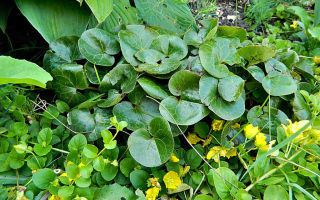Content
- 1 What it looks like and where it grows
- 2 Chemical composition
- 3 Why is the clefthoof useful and how it works for alcoholism
- 4 How to use European clefthoof for alcoholism
- 5 Advantages and disadvantages of using cleft grass for alcoholism
- 6 Contraindications to the use of clefthoof
- 7 Collection and procurement
- 8 Conclusion
- 9 Real reviews on the use of European clefthoof for the treatment of alcoholism
Since ancient times, the herb is used for alcoholism. Traditional healers have developed many recipes for treating addiction with this plant. When mixing a decoction of European Clefthoof with alcohol, a persistent aversion to alcoholic beverages arises. It is also used for digestive problems as a laxative and emetic.
What it looks like and where it grows
European Clefthoof is a herbaceous perennial plant. He belongs to the Kirkazonov family. This evergreen plant has a creeping rhizome and a branched stem that spreads along the ground. In some places, the European clefthoof covers large areas of land.
The plant got its name due to the special shape of the leaves. They resemble hooves in appearance. The surface of the leaves is glossy, dark green in color. They remain unchanged under the snow, and fall off in spring.
The creeping stem, on which the leaves are located, takes root in the ground as it grows. This is one of the ways of spreading the European clefthoof. It also reproduces by seeds. They are carried by ants.
The plant has a specific, bitter-spicy smell. The stems and leaves smell like camphor, and the roots smell like turpentine. The flowering period is in April and May, although the buds begin to form in the fall. In June, the seeds are already ripe.
Most often, the European Clefthoof is found in shaded areas. It grows well in mixed and coniferous forests. On the territory of Russia, it occurs in the forest and forest-steppe belts of the European part. It also grows in the southern regions of Western Siberia.
Chemical composition
Toxic substances are present in the European Clefthoof. Their action is used to induce aversion to alcoholic beverages in alcoholism. The leaves, roots and stems of the plant contain:
- glycosides;
- alkaloids;
- essential oils;
- organic acids;
- flavonoids;
- tannins.
The maximum amount of essential oils in the rhizome. In this part of the plant, they are contained in an amount of up to 3.5%. The main component of essential oil is the substance asarone. It is a strong poison. But many medicinal properties of clefthoof are due to the content of toxic substances in it. In small dosages, toxic components have a therapeutic effect.

Why is the clefthoof useful and how it works for alcoholism
The remedies made from the herb of the European clefthoof are used not only for the treatment of alcohol dependence. They have anti-inflammatory, expectorant, laxative effects. Decoctions, infusions are used to treat diseases of internal organs and systems.
Healing remedies from the clefthoof plant help get rid of alcoholism in the event that a drinking person does not know that they have begun to treat him. The grass and roots contain substances that, in combination with alcoholic beverages, provoke reactions similar to severe poisoning. A person who has taken alcohol and an infusion (decoction) of the common clefthoof begins nausea, vomiting, and the heart rhythm is disturbed.
Most people are frightened by this reaction of the body. After 3-5 repetitions, they develop a persistent aversion to alcohol, which is based on the fear of death. According to traditional healers, the clefthoof helps to induce aversion to alcohol on a psychosomatic level. After undergoing treatment, a previously addicted person has negative associations at the sight of any alcohol.
When using folk remedies made from European clefthoof:
- increased craving for alcoholic beverages disappears;
- the body is cleansed of toxic substances, ethanol breakdown products;
- the functioning of internal organs is normalized;
- excessive anxiety disappears;
- mood improves;
- sleep problems disappear.
After several tricks, the body is cleansed, the addicted person loses the desire to get drunk. But the remedies from the grass of the clefthoof, which cause disgust in alcoholism, at first provoke the development of ailments, a sharp deterioration in health. If a person has diseases of the digestive system, cardiovascular system, then medical attention may be required to recover.
How to use European clefthoof for alcoholism
For medicinal purposes, decoctions, water infusions and alcoholic tinctures of herbs and roots of European clefthoof are used. Healing products can be prepared independently or purchased from a pharmacy tincture.

Clefthoof tincture for alcoholism
You can create an aversion to alcohol with a tincture of wine. For its preparation, only the leaves of the European clefthoof are needed. They should be dried and crushed. In addition to the clefthoof, the tincture contains walnut skins. The components are taken in a 1: 2 ratio and poured over with alcohol. For 1 teaspoon of the mixture, 1 liter of wine is needed. The remedy is being prepared for two weeks. After the specified period has passed, the drink is given to a person who suffers from alcoholism, a glass before each meal.
Already after 3-4 days of such treatment, there is an aversion to alcohol. But there is a risk that the addicted person may develop intolerance only to the type of alcohol that made him feel bad.
Infusion
When taking an aqueous infusion of European clefthoof along with alcohol, a person begins to feel nausea, turning into severe vomiting. Prepare a remedy from 1 tbsp. dried herbs and a glass of boiling water. The infusion is done for four hours. The resulting liquid is added to vodka or other drink in the amount of 1 tbsp. l. 0.5 l.
If you take the clefthoof for alcoholism along with alcohol, then after a few days, intolerance will arise. A person gets the feeling that this is how the body reacts to previously favorite drinks.
Clefthoof decoction from alcoholism
A decoction is considered no less effective. To prepare a remedy for alcoholism from the clefthoof root, use the following recipe. You need 1 tbsp. l. of dried raw materials, pour a glass of boiling water. You need to cook the medicine for 5-7 minutes over low heat. Then the liquid is allowed to brew for an hour. Add the broth to alcoholic beverages or food on the basis that 1-2 tbsp is enough for one meal. l. facilities.

Drinking with coffee
The root of the European clefthoof works well in combination with coffee. To do this, pre-dried raw materials should be crushed with a blender or coffee grinder. The root is added to hot coffee.
After drinking alcohol during the day, the person will experience nausea, turning into vomiting. This condition is accompanied by a violation of the heart rhythm and the development of symptoms of general intoxication of the body.
Advantages and disadvantages of using cleft grass for alcoholism
Before you start taking or giving close people the herb of the clefthoof from alcoholism, you should evaluate the benefits and harms of the plant. It contains aristolochic acid. It is a potent delayed-acting carcinogen. The negative impact may appear after ten years. People who have consumed clefthoof medicinal products have an increased risk of liver or kidney cancer. But these organs are also affected by alcoholism.
The negative effect of the European clefthoof is possible with frequent use. If you add decoctions or infusions for 4-5 days in order to combat alcoholism, toxic substances will not have time to accumulate in the body. A short intake in the recommended amounts is enough for a person to be able to take advantage of all the beneficial properties of the European clefthoof. But if there are contraindications, even a single use can lead to negative consequences.
The action of the drug is based primarily on self-hypnosis. But thanks to vomiting, diarrhea, the body strenuously gets rid of the decay products of ethanol, so the craving becomes less pronounced, however, after a while, the dependence may return.
Contraindications to the use of clefthoof
Before you start taking folk remedies designed to get rid of alcoholism, it is advisable to consult a doctor. The consumption of this poisonous plant can lead to the development of serious health problems and exacerbation of existing diseases.
If there are contraindications to the reception, the medicinal properties of the clefthoof lose their significance. Herbal and root remedies are prohibited for such health problems:
- diseases of the gastrointestinal tract in the acute phase;
- hypertension;
- the development of withdrawal symptoms;
- the period of pregnancy and lactation.
In the absence of restrictions, the agent can be given only in established doses. Exceeding the recommended amount can be fatal even in cases where there are no contraindications. The toxic effect is enhanced by the intake of alcohol. Therefore, it is so important to observe the dosage during alcoholism treatment.

Collection and procurement
The herbaceous parts of the European Clefthoof are preferably harvested during the flowering period. But if at the end of spring there was no opportunity to do this, then the workpiece can be transferred to any month of summer. If it is planned to use the rhizome for medicinal purposes, then it is better to dig it up in mid-autumn or early spring.
Leaves are dried in shaded areas in the fresh air. Stir them periodically. The roots are washed in water, peeled from the earth and cut into pieces. They can be dried both outdoors in shaded areas and in electric dryers at temperatures from + 35 to + 40 C. Raw materials should be stored in glass containers, paper bags or wooden boxes.
Conclusion
According to the recommendations of traditional healers, the herb khoofen from alcoholism is widely used.With the simultaneous use of funds made from this plant and alcoholic beverages, symptoms of severe intoxication of the body occur. A person vomiting opens, the heart rhythm is disturbed, the general state of health worsens.
Real reviews on the use of European clefthoof for the treatment of alcoholism

